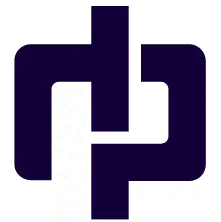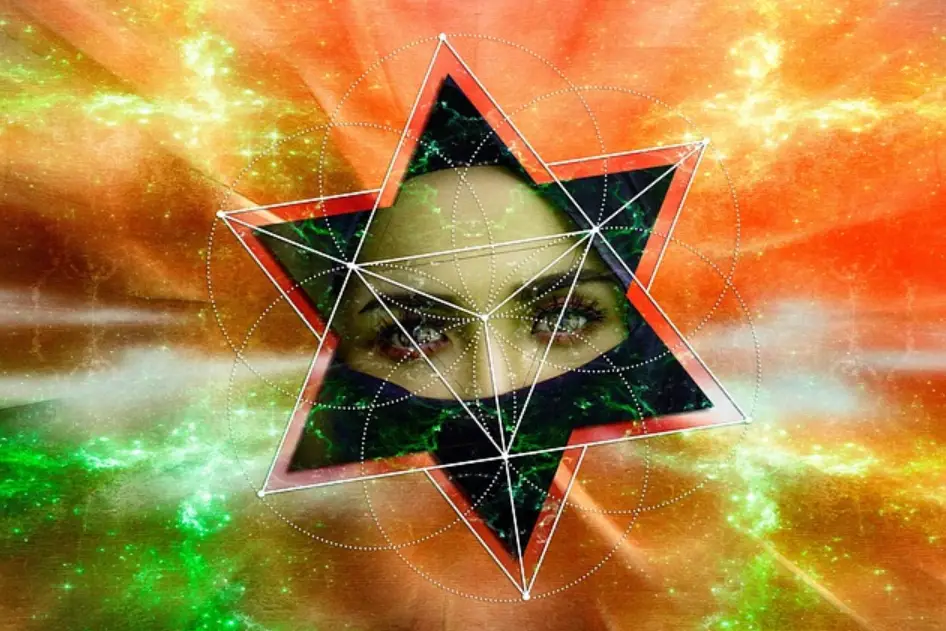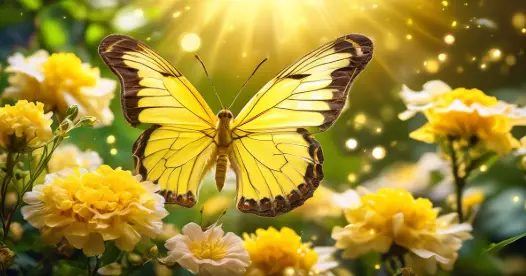The spiritual meanings of the triangle focus on unity, balance, and strength. Instead, the triangle is often considered a positive and strong symbol of unity between the mind, body, and spirit in many cultures. It is the sign of life’s cycle—birth, life, and death.
In religions such as Christianity, the triangle represents the concept of the Holy Trinity. In other spiritual traditions, it symbolizes a connection between the elements of earth, air, and water. As a symbol of protection and harmony, the triangle shape frequently appears in art, architecture, and jewelry.
Examining the triangle’s role in various cultures and religions reveals its profound impact. This seemingly simple shape has a deep, powerful meaning. The following sections elaborate on these meanings and how they manifest in everyday life.
Key Takeaways
- The triangle is an extremely potent spiritual symbol that embodies harmony, cohesion, and the relationship of the mind, body, and spirit.
- Throughout history and in various cultures and religions, triangles have represented the divine trinity, the cycles of life, and the need for balance between polarities.
- For example, different triangle orientations, like upward or downward points, have specific meanings associated with aspiration, grounding, and duality.
- In modern spiritual practices, triangles are used in meditation, energy work, and personal symbols like tattoos to enhance focus and express deeper beliefs.
- Triangles have been extensively used in sacred geometry, ancient architecture, and religious iconography, representing concepts like stability, transformation, and spiritual ascent.
- Incorporating triangle symbolism allows people to find balance, harmony, and clarity while manifesting their intentions. It further strengthens resilience by uncovering the spiritual dimensions of this ancient symbol.
What Is Triangle’s Spiritual Core?

One of Triangle’s spiritual core, the triangle represents the simple clarity of spiritual unity and deep connection. Its three sides and points together come to represent the important concepts of balance and harmony. Most importantly, they emphasize the relationship across the physical, mental and spiritual realms.
In almost all cultures throughout history, this shape has signified the intersection of human flourishing and divine intent.
1. The Divine Trinity Concept
Beyond its mathematical properties, the triangle has deep spiritual connections to oneness across religions. In Christianity, it shows the Holy Trinity: Father, Son, and Holy Spirit. In Islam, it connects to the three pillars of Taqwa, Ramadan, and the Quran.
Most of us see triangles as powerful symbols that show complex interconnections between different beliefs. For instance, the All-Seeing Eye represents an omniscient, all-knowing, directive force. In Mahayana Buddhism, three circling triangles make up the symbolic representation of the trikaya, or three bodies of enlightenment.
This shape supports people’s understanding of how spiritual concepts move and relate to one another.
2. Life’s Cycles: Birth, Growth, End
Triangles are a perfect visual representation of how life exists in cycles. Each point stands for a stage: birth, growth, and end. This undercurrent pairs well with the triangle’s seemingly unchanging appearance, depicting the duality of change and balance existing simultaneously.
Many spiritual traditions employ triangles to describe how our lives move and cycle through profound stages.
3. Mind, Body, Spirit Unity
The triangle as a symbol frequently represents the harmony between mind, body, and spirit. This union brings a deep sense of wholeness and encourages individuals to pursue their own well-being.
The third-eye chakra, located between the eyebrows, is triangular in shape. It represents a seat of intuition and discernment.
4. Time’s Flow: Past, Now, Future
It’s an alluring idea that triangles, particularly the spiritual triangle, could serve as a map of time—past, present, and future—using each point. This allows individuals to experience their lives through profound symbolism as a tapestry of past experience, present engagement, and future possibility.
5. The Foundational Number Three
Three is an important number in most religions as evidenced by the triangle. It is the number of harmony, balance and grounded, stable energy. You can observe this in symbols like the equilateral triangle, which has equal sides and angles of 60 degrees.
The ‘three-in-one’ concept resurfaces throughout many different religions, from Christianity through to Buddhism. This is just one example of how the triangle carries profound significance to many cultures.
Triangle Forms: Deeper Insights
Triangles have appeared throughout all spiritual traditions, each unique triangle shape conveying a different meaning. Their geometry—the fact that they are the same on every side or in the case of a triangle, oriented with one tip up—have complex implications. The way a triangle is positioned or grouped with other triangles can move the triangle from representing ambition to representing harmony.
We see these forms in art, sacred spaces, and even in the way people conceive of energy and balance.
Upward Point: Aspiration, Masculine
This upward point shape appears across cultures as a symbol of aspiration and the drive to achieve loftier objectives. With its base rooted and point extended high, it symbolizes the spiritual evolution and aspiration to go beyond. In Christian art, it is often used to frame scenes of the Holy Trinity, reminding viewers of interconnection and upward journey.
Buildings employ this form as well—just consider church steeples or medieval cathedrals.
Downward Point: Receptivity, Feminine
A triangle pointing down indicates a much different tale. It’s associated with receptivity, motherhood, the feminine, the natural, the rooted. This form resonates with water and the heart, drawing energy inward.
Religious communities have adopted it to represent faith and spirit, intuition, and the movement of emotion. You can see it in meditation symbols and rituals for inner introspection.
Interlocked: Harmony, Duality’s Union
Interlocked triangles—which form the Star of David—represent harmony and the union of opposites. They illustrate how dualities—such as fire and water, or mind and heart—can be interlocked to create wholeness.
This combination is particularly potent in Jewish and Hindu artistic expression. In many cases, it’s a tangible reminder that peace is achieved through reconciliation of two opposing sides.
Pyramid Power: Stability, Ascent
Pyramids extend the triangle shape into three dimensions, anchoring energy and elevating spirit. Ancient Egyptians built them for tombs and rituals, viewing them as steps to the divine.
These forms appear in contemporary buildings as well, used as symbols of power and unyielding expansion.
Dots Within: Hidden Meanings
Dots within triangle forms indicate hidden meanings or the beginnings of knowledge. This detail can be innovation, it can be revelation, it can be the catalyst that ignites transformation.
Indigenous American and Eastern artwork often depicts dotted triangles to symbolize the beginning of understanding or spirit.
Triangles in World Religions
Triangles appear again and again in spiritual traditions around the globe, often recognized for their profound symbolism. Others understand them as a bridge between the material and the heavenly, with the three sides and angles representing enlightenment, love, and the unity of perception and matter. These shapes resonate with profound foundations in ways that humans orient themselves toward existence, spirituality, and the cosmos at large, reflecting the spiritual triangle concept.
Christian Trinity and Providence
In Christianity, the triangle is a key symbol for the Holy Trinity: the Father, the Son, and the Holy Spirit. This configuration represents the oneness and equal cooperative relationship between these three. You find triangles in church windows, altar architectural design, and paintings. They are protective and remind us of God’s presence in steering us in the right direction.
Triangular motifs regularly adorn sacred narratives or delineate sacred spaces, providing a striking visual representation of the faith’s central virtues. The triangle, aside from being a reference to the trinity, is a symbol for divine providence. It is God-the-father who is present, attentive, and always engaged with the world.
Hindu Yantras and Deities
In Hinduism, triangles are used extensively in yantras, geometrical figures designed for meditation and worship. Many yantras include triangles pointing up for male gods and down for female gods. When connected, they form a symbol of harmony.
The triangle serves as a meditation tool, allowing practitioners to center themselves and attain spiritual enlightenment. Many temples include triangular rooms or sculptures, incorporating this triangle shape to welcome good vibrations and establish a link to the divine.
Buddhist Trikaya and Path
Buddhism connects triangles with the trikaya, or the “three bodies of Buddha.” Each point represents Dharmakaya (truth), Sambhogakaya (bliss), and Nirmanakaya (form). You might recognize this in art as three triangles whirling in a circle.
For some, this figure represents the journey to enlightenment. Buddhist teachings often employ triangles to illustrate how spiritual development gets stacked up on hundreds of layers.
Indigenous Spiritual Connections
Triangles appear in Native American, African and other indigenous spiritual practices. Perhaps they represent mountains, or teepees, or the wheel of birth, life, and death. These forms appear in weaving, pottery, and oral tradition patterns.
For those who feel it, the triangle connects humans to the land and sky – a point of intersection, creation, and divine intimacy between the natural and spiritual worlds.
Ancient Civilizations’ Triangle Use
Ancient Egyptians and Mesopotamians utilized triangles to build their pyramids and ziggurats. In this environment, triangles represented authority, stability and direction to their deities. The powerful triangular base and point soaring upward in these structures embodied metaphysical ideas about the origin of life and the journey to eternity.
Other cultures, such as the Norse, utilized interwoven triangles to represent concepts of destiny and spiritual connection.
Esoteric Triangle Wisdom
The triangle has been one of the most important symbols in esoteric thought for ages. Like a good story, it usually acts as a connective tissue between the visible and invisible. In this sense, esoteric wisdom refers to knowledge that is purposely concealed. It’s a secret because it’s only shared with those who are willing to look for the greater significance.
Triangles show up in spiritual practice, where they act as portals to greater insight. Wisdom Triangle Each side or point provides a perspective and path to wisdom. While each tradition approaches the triangle uniquely, all agree on the triangle’s potential as a transformative tool. It reveals esoteric wisdom and bridges the material and ethereal realms.
In Christianity, the triangle symbolizes the Holy Trinity. In Buddhism, it represents the Trikaya, or three bodies of Buddhahood, which are frequently built into temple layouts.
Sacred Geometry’s Blueprint
Sacred geometry is the study of patterns seen in nature and in ancient art, triangles are at the heart of it. The equilateral triangle has all sides and angles equal—60 degrees. As such, it is the symbol of balance and enlightenment.
Patterns such as the Star of David or the Sri Yantra interweave triangles to express harmony and evolution. These motifs usually represent the connection between the earth and the divine or between the body, mind, and spirit.
Alchemical Elemental Triangles
Alchemists use triangles to stand for the four elements: earth, water, air, and fire. Each triangle is either pointing up or down, occasionally with a line drawn through it. In concert, they create the alchemical elemental triangle that is the right container for change, transformation and enlightenment.
This ancient, sacred geometry assists seekers on their journey through cycles of death and rebirth, destruction and regeneration.
Numerology’s Power of Three
One of the most powerful numbers in numerology, three takes the form of a triangle, often referred to as the magic triangle. This geometric shape signifies growth, unity, and the flow of time: past, present, and future. Triangular symbols in sacred practice around the world typically embody profound symbolism, referring to the harmony among birth, life, and death, or creation, preservation, and transformation.
Palmistry’s Triangular Clues
In palmistry, triangles appearing in palm lines reflect the holder’s personality, luck, or fate. Many of our readers associate these shapes with the “third eye” and profound wisdom.
They leverage them as powerful tools to help their clients navigate their path towards self-knowledge and spiritual awakening.
Modern Triangle Spiritual Uses
Triangles are a common motif in modern spiritual practice. Beyond their ancient symbolism, they are beautiful tools for mindfulness, healing and self-expression! Others view the triangle as a passageway between the physical and spiritual realms. An equilateral triangle—each side and angle the same—symbolizes harmony and spiritual awakening.
Today, this shape is found everywhere in modern practice. You can hear it in meditation circles at yoga studios in Los Angeles and in healing spaces all over the U.S.
Meditation and Focus Tool
Triangles function as calming, centering forms in meditation. Traditionally, a triangle drawn on paper, a crystal, or even a folded cloth are used as focal points. Having your focus at the center point of the triangle can allow for an open mind and open space for you to take deeper breaths.
Many practitioners use the triangle to help direct their focus and intentions. In doing so, they tap into the historic concept of the triangle as a spiritual symbol of clarity. In Buddhist and Hindu meditation, practitioners utilize yantras constructed with triangular designs to deepen their concentration.
For example, the Shakti yantra consists of nine interlocked triangles that focus and transmit energy with power.
Energy Work and Healing
In holistic healing, the triangle often appears as an aid to support energy flow. According to some practitioners, the triangle’s points correspond to important chakras, most notably the third eye, which is associated with vision and intuition.
Triangles are employed in crystal grids or as hand gestures (mudras) to enhance energy work. In chakra balancing, a triangle shape brings your mind and body into concordance. This alignment allows us to more easily settle into a level, peaceful space.
Personal Triangle Tattoo Meanings
These tattoos have gained popularity, particularly as spiritual declarations. Others choose a triangle design in recognition of personal development. Some view it as symbolizing trust in life’s cycles, such as the symbol of the Celtic Triquetra.
The triangle might represent family, dreams, or a relationship to the universe, God, or higher power. Inverted triangles are often associated with feminine energy, the moon, or new beginnings.
Art, Iconography, and Expression
Artists continue to interlace triangles into contemporary spiritual artwork to represent transformation, harmony, or as a bridge between realms. Others use three triangles combined, as in the trikaya symbol from Mahayana Buddhism, to represent enlightenment’s complex nature.

Some go deep into Christian, Islamic or Celtic usage, marrying ancient and modern significances. Triangle shapes appear in murals, jewelry, and even digital art — reminding us that the symbol is intimate and real.
Triangle’s Energetic Blueprint
The triangle has long been a powerful symbol in spiritual traditions, serving as a spiritual triangle tattoo that charts energy. Its energetic blueprint, rooted in Pythagorean principles, employs a right triangle with squares on each side, showcasing profound symbolism. This colorful structure offers a holistic perspective, illuminating the patterns of life around us and revealing opportunities and dangers through data ranging from 1 to 78.
In essence, each line on the triangle blueprint signifies a stage of life, contributing to the understanding of spiritual symbolism. This key process provides visibility into the sixfold wealth of experience gained over twenty-seven years, while the major process evidence reflects a dual experience learned after nine years. Participants inscribe the letters of their name along the lines, with each line representing nine years of personal development.
This aspect of the triangle fosters a real-time, dynamic learning environment, enhancing individual growth and understanding of the triangle message in daily life.
Triangles as Energetic Pathways
Triangles are noted to be energetic pathways. They connect points of interest, allowing energy to flow through them. This is why so many incorporate triangles into spiritual rituals.
The triangle’s three sides can point to different concepts across cultures: the Holy Trinity in Christianity, the three bodies of Buddha, or the core elements of Muslim life. In feng shui, triangular shapes with points facing up represent the fire element, adding a sense of warmth or spark to a room.
Manifesting with Triangle Focus
People work with triangles in manifestation by cultivating intentions inside a physically created or visualized triangle. Keeping the emphasis on that great geometric shape helps sharpen the intent.
Many rituals incorporate three candles at the triangle points or simply draw a triangle on paper to contain written wishes. This form can serve as a conduit, providing energy an obvious route.
Elemental Triangle Associations
Triangles are associated with the elements of fire, water, air, and earth. An upside-up triangle usually represents the element of fire or air, and an upside-down triangle, the element of water or earth.
In ceremonial practice, drawing a triangle in the air may “call in” elemental aid — centering an individual or igniting an epiphany.
Resilience: Triangle’s Inner Strength
The triangle’s durable form symbolizes that resilience. Its elegant shape is what allows it to resist great force without flinching.
Residents turn to the triangle as a symbol of resilience to remain calm amid storms and emerge mightier from adversity.
Dream Meanings of Triangles
Dreaming of triangles usually indicates a need for stability or a decision between two life paths. Some dreamers experience triangles as a prompting to pursue harmony, or as communications regarding decisions.
In these instances, the triangle helps to direct them to contemplate what is needed on their spiritual journey.
Conclusion
Triangles seem to appear all around us, from windows in our churches to the mats we use for yoga. People interpret them as powerful symbols of equilibrium, development and peace. Some folks use them for focus in meditation, while others spot them in art or nature and feel a sense of order. The form unites the past and the present, from traditional practices to modern wellness innovations. It is at once simple and profound.
Next time you see a triangle, think about its layers—maybe it’s pointing you to something steady or a new path. Have a story or idea of what triangles represent to you? Leave it in the comments or pass it along to that spiritual signs-obsessed friend. We hope to continue the discussion further.
Frequently Asked Questions
What is the spiritual meaning of a triangle?
As a spiritual shape, the triangle, particularly the upward pointing triangle, represents creation, stability, and enlightenment, symbolizing ascension and spiritual awakening.
How do triangles appear in world religions?
Triangles hold profound symbolism across various spiritual traditions, such as the upward-pointing triangle representing divine unity in Christianity’s Holy Trinity and the downward triangle symbolizing strength in Native American cultures.
What is the significance of upward and downward triangles?
An upward triangle, embodying profound symbolism, represents masculine energy, fire, and ambition, while a downward triangle symbolizes feminine energy, water, and intuition.
How are triangles used in modern spiritual practices?
In modern spiritual practices, the magical triangle is used in meditation, chakra balancing, and crystal grids to help sharpen and funnel energy while creating spiritual protection.
What does the triangle’s energetic blueprint mean?
The triangle’s energetic blueprint, embodying profound symbolism, collects, filters, channels, and amplifies energy, making it a valuable tool in spiritual rituals and energy healing.
Why is the triangle considered powerful in esoteric traditions?
In esoteric traditions, the triangle, often referred to as a magical triangle, serves as a powerful bridge between spiritual and physical worlds, offering profound symbolism that enriches one’s insights.
Can I use triangle symbols at home for spiritual benefits?
Using triangle symbols at home can enhance your spiritual experiences, raising your vibration and connecting you with profound symbolism and the magic triangle.







